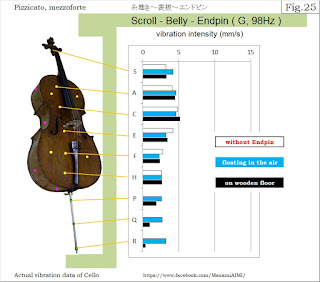[ 9/18/2016 ] Labels: A1..AEH
Try placing your cello on the floor, pluck the C string and watch the body vibrate. The bottom plate (lower bout ribs) and the endpin fixed to it both vibrate as well. Although you cannot see the vibration, you can feel if you touch the tip of the endpin. The vibration is stronger than you may think. If you stop the vibration by holding the tip of the endpin, you will notice a subtle change of sound.
The first modern cello is said to have been created about two hundred years ago with the introduction of the endpin, which helped to greatly enhance the instruments performance. However, with the endpin fixed in one place on the floor there is a possibility of spoiling the cello's natural resonance.
Is it possible to hold a cello in place with the endpin without losing its perfect sound?
The Advanced Endpin Holder holds a cello in place while letting the endpin float slightly in the air. Its design allows the vibration from the cello's body through the point of the endpin, both horizontally and vertically, to sustain as well as possible. At the same time it gently holds the cello in place, leaving room for the tip of the endpin to vibrate.
Consequently, you can expect the improved effects listed below in comparison to the sound achieved when either resting an endpin directly onto the floor or with a rubber cap attached.
1. The Advanced Endpin Holder enables the cello's sound to be close to an original natural resonant vibration and provides gentle and comfortable sounds with full harmonic overtones.
2. It enables the player to perform with more sensitive expression as it improves the articulation and separation of the sounds by reducing the resistance from the strings, especially in the middle and lower range of sound.
You can experience an unknown field of improved sound and an articulation which is reminiscent of the Baroque cello's splendid sound and clear articulation.



















